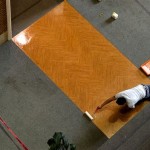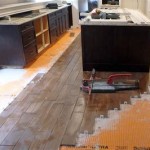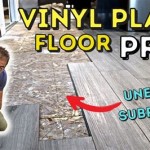How To Repair Subfloor In A Mobile Home
Mobile homes, also known as manufactured homes, offer an affordable housing option for many. However, like any dwelling, they are subject to wear and tear, and the subfloor is particularly vulnerable. The subfloor provides the foundation for the flooring, and damage can lead to uneven surfaces, squeaking floors, and potential structural issues. Understanding how to repair a subfloor in a mobile home is a crucial skill for homeowners aiming to maintain their property's value and livability. This article offers a comprehensive guide to identifying, assessing, and repairing subfloor damage in mobile homes.
Mobile home subfloors differ from those in traditional stick-built houses in several ways. They are typically thinner, often consisting of plywood or oriented strand board (OSB) ranging from 5/8 inch to ¾ inch in thickness. The subfloor is commonly attached to a metal frame underneath the mobile home. These differences necessitate specific approaches to repair and maintenance. Ignoring subfloor issues can result in more extensive and costly repairs later on. Early intervention is key to preserving the integrity and longevity of your mobile home.
Before commencing any repair work, safety is paramount. Ensuring the power is turned off to the area where repairs are needed is essential to prevent electrical shock. Wearing appropriate personal protective equipment (PPE), including safety glasses, gloves, and a dust mask, will protect against splinters, debris, and potentially harmful substances like mold. Proper ventilation is crucial, especially when using chemicals or working in enclosed spaces. Furthermore, having a helper is recommended, particularly when handling large or heavy materials. A clear understanding of the mobile home's structure and construction is helpful to avoid inadvertently damaging plumbing, electrical wiring, or other critical systems during the repair process.
Identifying Subfloor Damage
The first step in repairing a subfloor is accurately identifying the location and extent of the damage. Common signs of subfloor problems include soft spots, sagging floors, visible water stains, and musty odors. Carefully inspecting the area in question is crucial. This may involve removing the existing flooring, such as carpet, linoleum, or tile, to gain a clear view of the subfloor beneath. A flashlight can be helpful in illuminating dark corners and detecting hidden damage. Pay close attention to areas around plumbing fixtures, such as toilets, sinks, and showers, as these are common sources of water leaks that can lead to subfloor rot.
Walking across the floor and paying attention to any areas that feel spongy or give way under pressure can reveal weak spots in the subfloor. These areas may be indicative of delamination (separation of the layers of plywood or OSB) or actual wood rot. A visual inspection from underneath the mobile home, if accessible, can provide further insights into the condition of the subfloor. Look for signs of water damage, insect infestation, or structural weakening. A screwdriver or awl can be used to probe suspected areas of rot. If the wood is soft and easily penetrated, it likely needs to be replaced.
It is important to distinguish between minor surface imperfections and more serious structural issues. Small cracks or surface blemishes may not require immediate attention, but they should be monitored to ensure they do not worsen over time. However, widespread water damage, significant wood rot, or sagging floors should be addressed promptly to prevent further deterioration and potential safety hazards. Documenting the damage with photographs can also be useful for future reference and for insurance purposes, if applicable.
Preparing for the Repair
Once the extent of the subfloor damage has been assessed, the next step is to prepare for the repair. This involves gathering the necessary tools and materials and taking steps to protect the surrounding area. The tools required will vary depending on the nature and scope of the repair, but typically include a circular saw, jigsaw, drill, hammer, measuring tape, level, utility knife, safety glasses, gloves, dust mask, and a pry bar. A moisture meter can also be helpful for verifying that the subfloor is dry before installing new flooring.
Selecting the appropriate replacement materials is crucial for a successful repair. Matching the thickness and type of subfloor material is important to ensure a smooth and even transition between the old and new sections. Plywood or OSB that is specifically designed for subfloor applications is recommended. This material is typically moisture-resistant and provides adequate structural support. When selecting fasteners, such as screws or nails, choose those that are corrosion-resistant to prevent them from rusting and weakening over time. Galvanized or stainless steel fasteners are good choices for mobile home subfloor repairs.
Protecting the surrounding area is essential to prevent further damage and simplify the cleanup process. Cover any exposed furniture or belongings with plastic sheeting to protect them from dust and debris. Use painter's tape to mask off adjacent surfaces that you do not want to be damaged or stained. When cutting or sanding, use a vacuum cleaner or shop vac to collect dust and debris as you go. This will help to minimize mess and improve air quality. Proper preparation can save significant time and effort in the long run and ensure a professional-looking finished result.
Performing the Subfloor Repair
The actual repair process involves removing the damaged section of the subfloor, installing the new subfloor material, and securing it in place. The first step is to carefully cut out the damaged section using a circular saw or jigsaw. Be sure to set the cutting depth to the thickness of the subfloor to avoid cutting into any underlying structures, such as plumbing or wiring. When cutting, follow the existing framing members (joists) as much as possible to provide solid support for the new subfloor. A pry bar can be used to carefully lift and remove the damaged section of the subfloor.
Once the damaged section has been removed, inspect the exposed framing members for signs of damage or rot. If any rot is present, it should be treated with a wood preservative or replaced entirely. Measure the opening carefully and cut the new subfloor material to fit snugly into the space. It is often helpful to create a template of the opening using cardboard or paper to ensure an accurate fit. Before installing the new subfloor, apply a bead of construction adhesive to the top of the framing members to provide additional bonding strength. Position the new subfloor section in place and press it firmly onto the adhesive.
Secure the new subfloor to the framing members using screws or nails. Screws are generally preferred because they provide a stronger and more durable connection. Space the fasteners evenly, typically every 6-8 inches along the edges and every 12 inches in the field. Be sure to drive the fasteners flush with the surface of the subfloor to prevent them from interfering with the installation of the new flooring. After the new subfloor has been secured, inspect the area for any gaps or unevenness. If necessary, use wood filler or patching compound to fill any small gaps and sand the surface smooth to create a seamless transition between the old and new sections.
After the patching process is finished, it is important to seal the repaired subfloor with a suitable sealant. This will help to protect it from moisture and prevent future damage. Apply a generous coat of sealant to the entire surface of the repaired area, paying particular attention to the edges and seams. Allow the sealant to dry completely before installing the new flooring. Regular inspection and maintenance of the subfloor can help to prevent future problems. Check for signs of water leaks, insect infestation, or structural weakening, and address any issues promptly. Keeping the area under the mobile home clean and dry can also help to extend the life of the subfloor.

Mobile Home Subfloor Repair Guide The Dealer

How To Repair Sub Floor In A Trailer House Or Mobile Home

Mobile Home Subfloor Repair Guide The Dealer

Floor Removal How To Patch A Mobile Home Bedroom Renovation

How To Replace Subflooring In A Mobile Home Step By Guide Living

How To Replace Flooring In A Mobile Home Star Supply Usa

Mobile Home Floors Sub Floor Repair

How To Replace Subflooring In A Mobile Home Step By Guide Living

Mobile Home Floors Repaired Sub Floor Repair

Replacing Subfloor Mobile Home Floor Repair Water Damage Part 3
Related Posts








